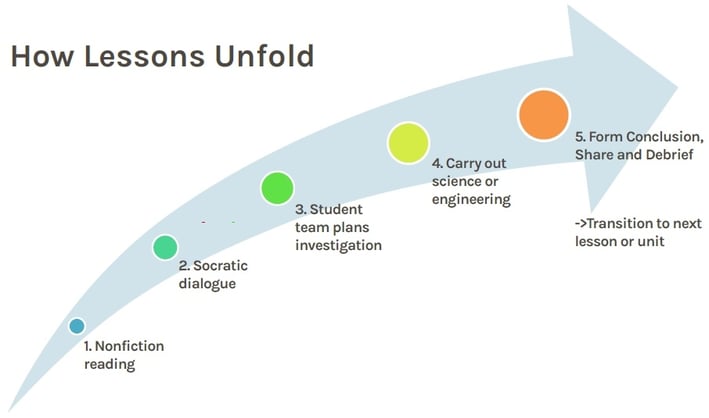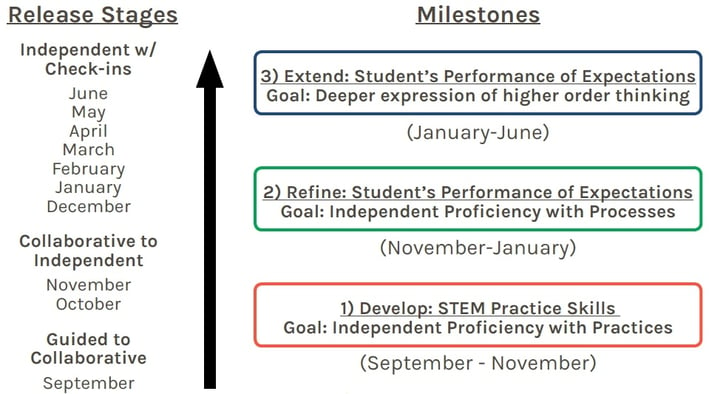The new definition of effective STEM instruction hails directly from the National Research Council, explaining, "Effective STEM instruction capitalizes on students' early interest and experiences, identifies and builds on what they know, and provides them with experiences to engage them in the practices of science and sustain their interest."
Note the deliberate wording: providing students with experiences to engage them in the practices of science and sustain their interest. This wording is not ours, but the National Research Council's ideal of what forms the basis of these new standards.

Effective STEM instruction capitalizes on students' early interest and experiences, identifies and builds on what they know, and provides them with experiences to engage them in the practices of science and sustain their interest.
This is a significant shift in instructional approach, exemplified by transitioning out of what you see in the traditional picture on the left to what you see in the next generation environment on the right. On the left, we see students watching as a teacher demonstrates how to do something. On the right, we see students actually engaging with the science and engineering practices to answer their own questions and solve their own problems. These students on the right have done some nonfiction reading. They had a Socratic dialogue with their class, and now they are trying to solve a problem, extending what they know using the skills they've developed.
The salient point is that in the new model, students don't have to simply parrot back what the teacher does, but can devise their own approaches and learn from testing their own ideas.
Moreover, effective STEM instruction starts by capitalizing on students' early interest and experiences. This starts before kindergarten and builds through the earliest grades, following and nurturing students all the way up to high school graduation. At each month and grade level, the curriculum should build on what students know so that each lesson and unit is thoughtful and intentional, scaffolding within the year as well as from year to year. What value does it really add, after all, to study butterflies in springtime simply because that's a good time to release them, when students have just finished studying electricity? How does that scaffold or add value to their learning? Unless you're getting down to the nitty-gritty of sodium-potassium ion pumps and how butterflies actually move—in which case our hats are off to you—there isn't much of a connection between electricity and butterflies.
Instead, we must spend more time and effort identifying and building on what students know. Scaffolding is another common point of misconception. It's not good enough to know what they've learned in the previous lesson or unit within the year; we must also take into account what needs to be done to build on the year before and to support the lesson, unit, and year that comes next. This, and only this, will help ensure that students are college- and career-ready and will be able to perform well content-wise as well as in terms of knowledge and skills.
An Open-Ended Process

The experience we create in the classroom has to bring the three dimensions to life in a meaningful context and in such a way that students are fully engaged in the practices of science and engineering.
It's important to understand going into a lesson that students don't know how a problem is going to be solved or how a question is going to be answered, and teachers don't know how they're going to decide to go about either. Nobody has given them a demonstration or shown them. It's up to them. They either will or will not solve the problem. It's their job as engineers to take their idea, bring it to life, gather the data and reflect back on it. That doesn't mean the teacher is not involved in checkpoints and helping to monitor, redirect and differentiate concepts, but there is a full release of responsibility happening over time, to which the class has been working up toward in the first 10 weeks. It's a very different expectation and a very different type of performance from students than in the traditional model, which is why these new standards are rendered as performance expectations in three dimensions.

A full release of responsibility is a key part of maintaining rigor in the classroom.
In order to meet the performance expectation, students must have the ability to engage with all three dimensions. They will need the science and engineering practices, or the skills which enable them to engage with materials. They will need disciplinary core ideas, the knowledge that gives them an awareness of the subjects they're learning about. And lastly, they will need awareness of the crosscutting concepts, that ability to connect various disciplines and explain where the interconnections lie in the phenomena they observe.
In NGSS-aligned curriculum, the teacher sets the main expectations of the students, then scaffolds the instruction and gradually releases responsibility over time. Good curriculum gives them effective guidance so they can in turn deliver effective science and engineering instruction in the classroom, and they can do it hands-on in a problem-based sense every lesson of the year, all year long, and from one grade level to the next. This ensures that students are constantly being intentionally nurtured one grade to the next and from September through June (or August through July, depending on where you're coming from).
In the next generation model, we expect students to use the same skills to answer different questions and different problems and continue to apply these skills again and again in various situations. We also expect them to use system behavior to describe dynamic behavior, again in a wide range of expectations, by understanding the crosscutting concepts and being immersed in the practices. It's just like the English language: we use words over and over again all day long, but we say different things each time. We use those language skills over and over again, depending on the situation. The same is true of the STEM practices.
This open-ended process allows students to continually expand their understanding of subjects and work in all three dimensions, preparing them to apply their skills and knowledge to any situation that might come their way. This stands in stark contrast to the traditional model, in which students go through rote activities and are afterwards prepared only to complete that activity again, or one that is very similar. Students instructed in the new model of STEM instruction, on the other hand, have the ability to apply their learning to a wide variety of contexts.
In our next article, we will briefly cover how arts relate to STEM and how we might expect them to intersect in the new model of instruction.





